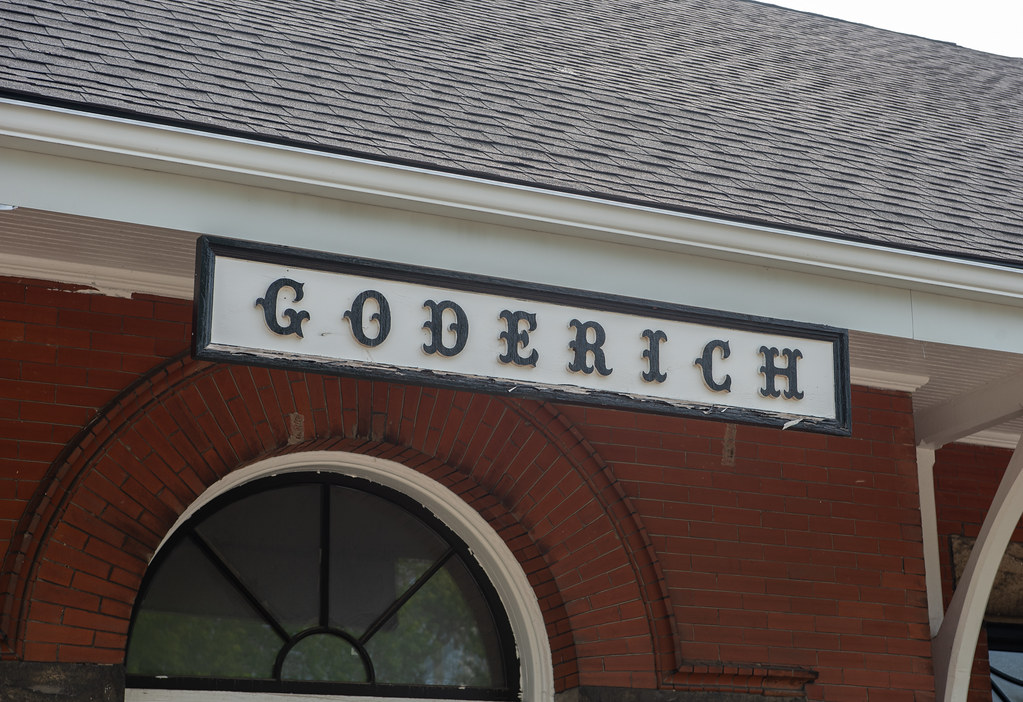One such location that gave me a bit of trouble with research is the old Grand Trunk Railway station in Goderich. Sitting next to the rails it once served yet still within sight of the downtown; this old station remains a bit of mystery still today. When it comes to the history of the railroad in Goderich, it is a bit muddy.

Graflex Crown Graphic – Fuji Fujinon-W S 1:5.6/150 – Ilford HP5+ @ ASA-200 – Pyrocat-HD (1+1+100) 9:00 @ 20C
The railroad first came to Goderich in the form of an idea; economic forces joined with peers from Brantford and Buffalo to build a line that ran between the three locations in response to the lack of commitment from Great Western and Grand Trunk. The Buffalo & Lake Huron Railway struggled through the first years before pushing through Stratford in 1856 and finally arriving in Goderich two years later. While the primary purpose of the railway would be to connect to Chicago via the upper Great Lakes, the railway company positioned their first station reasonably distant from the harbour and the downtown. The simple shed style station stood where the rail line crossed the Huron Road, today Highway 8. The exact look of this first station is unknown as no photographs exist of the original station. By 1864, Grand Trunk had assumed control over Buffalo & Lake Huron and continued operations. By 1873 a new station had been constructed near where the first station had stood. Again there is no physical record of this second station. There is a good chance the station followed a Gothic Revival style and was constructed out of wood. It may have even looked like the station Grand Trunk completed in Stratford during this same period.

Nikon D750 – AF-S Nikkor 28-70mm 1:2.8D
Nikon D750 – AF-S Nikkor 28-70mm 1:2.8D
Under the guidance of Charles Hayles, Grand Trunk launched a modernisation program of many of their older stations starting in 1896. Given that Goderich sat at the end of a line, the old station stood for replacement. Rather than use the existing location, Grand Trunk moved the station closer to the downtown, setting it at the end of East Street, with a straight line right into the centre of town. The new station also showed off the new profitability of Grand Trunk, being constructed with a limestone foundation and details and a red brick exterior. The overall style is a blend of the popular Queen Anne Revival style with some Victorian elements remaining. The station featured a pair of round towers on the street-facing side and a couple of square towers on the rail side. The roof featured a pair of dormers into the upper attic area. A porte-cochère provided shelter for arriving passengers. The interior featured a single waiting room with a separate smoking room for men, a station master’s office and a ticket window. A telegraph operator bay and baggage room completed the station. The passenger areas were well appointed with tile floor, big bright windows and good lighting. A fire in 1910 gutted the new station; rather than replace it, Grand Trunk instead restored the station. However, the reconstruction eliminated the dormers and square towers and combined the waiting rooms into a large single one to save time and money. Canadian National took over operations in 1923 and, throughout the next half-century, changed little about the station. It never even received a coat of paint in the mid-century. Passenger services out of the station ceased in 1973. Canadian National continued to maintain freight and yard operations out of the old station until turning over the entire branch line, yard, and station to the Goderich-Exeter Railroad in 1992. The old station became the headquarters for the shortline operator. Railroad operations continued from the station until 2001, when they were moved to Stratford.

Nikon D750 – AF-S Nikkor 28-70mm 1:2.8D
Nikon D750 – AF-S Nikkor 28-70mm 1:2.8D
While Goderich-Exeter continues to use the rail yard and branch line, the station was sold to a local construction firm that used it as their main office. During this time, the station underwent a renovation to support its use as a commercial space, and after seven years, the station looked worse for wear. Katrina Bos purchased the station in 2008; under her direction, it underwent a series of renovations and restorations to restore at least the exterior to how it looked in 1910. Bos opened the old station under the name East Street Station as a community hub and event space for local not-for-profit groups who needed meetings and similar events. East Street did not last long, and in 2010 the station came under the ownership of a local media group. FauxPop Media again conducted an extensive renovation of the old station converting it into a media production facility for television and film productions. While I’m unsure if the station remains in use, FauxPop Media maintains a presence on Social Media with references to the station.